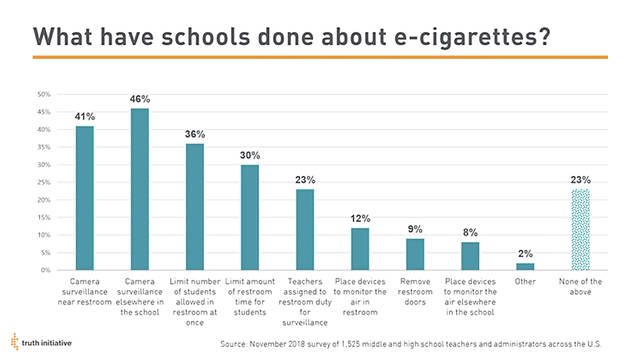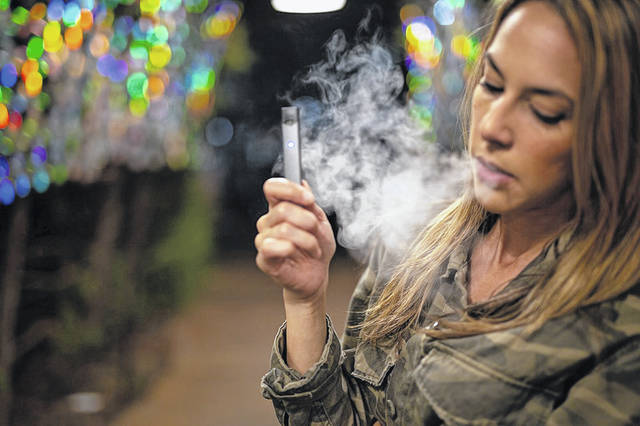


SIDNEY – As high school and college students return to classes, parents need to talk to their children about the health hazards of vaping, an increasingly popular form of nicotine consumption using e-cigarettes and other devices.
As a growing problem among youth, state and federal government agencies are cracking down on e-cigarettes. Ohio recently restricted the practice by prohibiting sales to those under 21 years of age, raising the minimum age from 18, alongside proposed federal legislation that aims to add an online sales tax. Vaping was legal in Ohio for many high school seniors, but now, parents and schools must pick up the pieces of as nicotine withdraw sets in among young people who may have started vaping over the summer. Dave Dilbone, principal of Troy High School, provides some insights into how parents and schools can work together to reverse this alarming health trend.
Statistics show vaping increased in parallel with a decrease in smoking. But the increase in vaping numbers is not due to entirely to smokers trying to quit, but an explosion of new nicotine users among teens. Last year the Centers for Disease Control (CDC) estimated “3.6 million U.S. middle school and high school students used e-cigarettes,” a demographic representing “4.9 percent of all middle school students and 20.8 percent of all high school students.” By February 2019, the CDC reported that figure rose by more than a million students to 4.9 million, with the fastest-growing demographic being middle school students—roughly 7.2 percent of middle school and 27.1 percent of high school students had used e-cigarettes or vaping products in the last 30 days.
To help combat this epidemic in Ohio, on July 18, 2019, Gov. Mike DeWine signed the state’s budget, immediately putting into effect raising the age limit for the purchase of tobacco and vaping devices to 21. Dewine vetoed a line item that would grandfather individuals aged 18-20 prior to Oct. 1, effectively leaving those teens already hooked with a nicotine withdraw problem while not simultaneously offering a state-funded addiction solution specifically aimed at this demographic.
Ohio Congresswoman Joyce Beatty is a co-sponsor of H.R.3942 – Preventing Online Sales of E-Cigarettes to Children Act. However, the title and text of the bill (https://www.congress.gov/bill/116th-congress/house-bill/3942/text) seem incongruous. The legislation appears to be solely focused on adding a new tax for online sales of e-cigarettes regardless of age, failing to indicate how much, if any, of the tax revenue would be spent to help pay for youth nicotine addiction prevention and treatment—especially in low income districts that could certainly benefit from such revenue. What seems more obvious is that this legislation applies additional pressure for e-cigarette companies to get FDA approval or face a lot of new taxation on their products. This is because Section C says products “approved by the Food and Drug Administration for sale as a tobacco cessation product” would be excluded from the online sales tax. E-cigarettes like JUUL have yet to obtain FDA approval, even though tobacco cessation appears to be one of their marketing claims and a Maryland court order issued on Friday is applying more pressure on JUUL and other e-cigarette companies to obtain FDA approval quickly.
Health effects of vaping
While many teens mistakenly believe they are only breathing in water vapor, nicotine, and flavor, according to the American Lung Association (ALA), in January 2018, “the National Academies of Science, Engineering and Medicine1 released a consensus study report that reviewed over 800 different studies. That report made clear: using e-cigarettes causes health risks. It concluded that e-cigarettes both contain and emit a number of potentially toxic substances.” The ALA specifies that these include “acetaldehyde, acrolein, and formaldehyde. These aldehydes can cause lung disease, as well as cardiovascular (heart) disease. E-cigarettes also contain acrolein, a herbicide primarily used to kill weeds. It can cause acute lung injury and COPD and may cause asthma and lung cancer.”
What’s more, the method of using liquids for vaping is similar to that of how tetrahydrocannabinol (THC) found in cannabis oil can be inhaled, and indeed some of the vaping liquids are suspected to contain it, necessitating medical treatment or hospitalization. By August 27, 2019, the CDC reported 215 potential cases across 25 states, saying “many patients have reported using e-cigarettes containing cannabinoid products such as THC or CBD.” Six such cases of pulmonary illness following vaping occurred in Ohio. Stanton A. Glantz, Ph.D. at the UCSF Center for Tobacco Control Research and Education advised parents and students need to be aware that e-cigarettes are “a gateway drug for marijuana.” Stanton cited a 2018 study published in Pediatrics which found “any e-cigarette use at baseline about doubles the odds of using marijuana a year later,” One UCSF clinical trial currently underway cited a 2015 study published in Pediatrics that showed “high rates of cannabis vaping among high school students (18.0% among ever e-cigarette users).”
Those inhaling THC-laced e-cigarettes or vape products could face legal repercussions should they test positive for cannabis use by law enforcement. According to Mayo Clinic, urine tests are used to screen for marijuana use and “detection of marijuana can occur in the urine for greater than 30 days after cessation among chronic users, whereas single exposure to marijuana in nonusers typically can be detected in the urine only up to 72 hours.” The same study pointed out that also holds true for those exposed by “passive inhalation” (also called second-hand smoke) in rooms without ventilation. For parents who may think THC-laced e-cigarettes are a problem only in other states, they need to know it is right here in Ohio. In April 2019, ABC’s News 5 reported “more than 15,000 THC vaping cartridges [were] seized by DEA agents in Cleveland.”
Teens vaping in school
Disguised as USB devices, e-cigarettes are finding their way into schools so that teachers and administrators are confiscating them. According to Dave Dilbone, principal of Troy High School, “if we think it contains THC, we would involve our Resource Officer, because that is a whole separate avenue we would go down in terms of the drug and criminal side of it.”
“It’s almost a moving target. You try to stay on top of the latest trends, but whenever you turn around there’s a new change,” Dilbone said. The latest trend he’s heard of are toothpicks that contain nicotine.
Unfortunately, students are not taking the dangers of vaping seriously. “There was a game last year I heard about from out of state. Students were charging their e-cigarettes in a teacher’s computer. They were making it a game because it looks like a USB drive. I found a video clip and was able to share that with the staff, which they were obviously blown away and hadn’t heard of such a thing,” Dilbone said.
But nicotine addiction brought on by vaping is anything but a game. Biochemical changes in smokers and vapers cause them to suffer withdrawal. According to WebMD, nicotine withdrawal symptoms “may include headaches, anxiety, nausea, and tobacco cravings.’ Mayo Clinic also adds the following adverse withdrawal symptoms: “irritability, restlessness, difficulty concentrating, depressed mood, frustration, anger, increased hunger [and] insomnia.” One Columbus, Ohio mother is suing JUUL Labs because, according to her attorneys, “her twin daughters began JUULing at 14 years of age and became severely addicted to nicotine,” resulting in “strong mood swings, bouts of anger and aggression, discipline problems, and a decline in academic performance” and “one of her daughters even attempted suicide due to nicotine withdrawals.”
Vaping consequences for students and athletes
Dilbone considers it the responsibility of schools to educate teens about the health hazards of drugs, tobacco, and vaping. At Troy High School, all students attend a mandatory health class where information is provided. In addition, said Dilbone, “last year we brought in two speakers, one by the name of Chris Herren who spoke to students. He was a professional athlete who dealt with addiction and really provided a powerful message to our student body about what that did in terms of damaging his career and the difficult road back that he had from that life of addiction.” Herren is a former NBA star who became addicted to a variety of drugs. He later started the Herren Project to provide others with education and assistance with addiction prevention and recovery.
For additional advice to help counteract the vaping trend among youth, Dilbone relies on county-based social services, nonprofits, and for-profit companies.
“We have a pretty strong partnership with the Miami County Recovery Council (MCRC) as well as the Tri-County Board of Mental Health,” which covers Miami, Darke, Shelby counties, he said, “so we lean on those experts in terms of trying to get some additional educational materials.” Dilbone says this year he plans to implement materials and vaping classes offered by the MCRC, a private nonprofit offering alcohol, drug and mental health services.
Dilbone said that, in addition to the MCRC, commercial companies also can contract with schools to provide educational materials. If Troy High School students are caught possessing vaping devices, they are sent to in-school restriction (suspension) where they may receive materials pertaining to why they are there. Following a pilot program last spring at the Troy High School, Dilbone said, the school is currently pursuing a vendor to provide a module that students complete “that talks to them about the dangers of vaping and e-cigarettes.” Other options they are considering involve placing devices in restrooms.
This year Troy High School increased its vaping policies when athletes are found possessing or using—whether at school or not. Being caught possessing or using likely will result in violations of the athletic code of conduct in many schools, potentially suspending or ending that player’s athletic career. From a health perspective, high doses of nicotine from e-cigarettes like JUUL can negatively impact an athlete’s performance on the field and lead to lung and cardiovascular illness.
In January 2019, the Truth Initiative published their research about strategies schools are using to combat the vaping and e-cigarette epidemic (https://truthinitiative.org/research-resources/emerging-tobacco-products/how-are-schools-responding-juul-and-youth-e-cigarette).
In reaction to the change in Ohio law, Dilbone says, it’s “a huge win for us as a school.” Once students receive a clear message—that it is not legal to sell to anyone under 21, that the school will not tolerate it, and that there are various in-school and athletic consequences—some students may actively report violators to trusted teachers, school counselors, or administrators.
“Here at Troy High School we have a very strong culture within our student body and students are willing to speak up” or they use the anonymous online Student Help Line (a link to which is available on the Parent Resources page on the Troy City Schools website).
More importantly, Dilbone emphasized, Troy City Schools are building a culture that is “trying to work in all of these things, including vaping and e-cigarettes, into the Trojan way. We’re posting signage in the buildings that talks about ‘Together; Resilience; Own It; You Matter.’ (TROY). We talk with them about being resilient. It’s hard to say ‘no’ sometimes but you need to be able to do that and walk away.” Incorporating this philosophy is “something we’ve done as a district, not just at the high school,” he said.
Addiction prevention, however, is just as important at home as it is in school. Dilbone’s advice to parents is to “look for changes in behavior. Above all, talk to your kids. Make sure that they know you care for them. Make sure they know that home is a safe place and try to have some of these conversations before it becomes a problem. What we’ve seen, and what the experts tend to tell us, is that it’s much more difficult [to overcome] once it becomes a problem if you haven’t started that conversation days, weeks, or years ahead of time.”
Denny Morrison, principal at Sidney High School, says their policies are similar.
“I’m more concerned about the long-term damage that they are doing. The seriousness of e-cigarettes and vaping are just now being discovered. Right now, the vaping companies are certainly trying to attract young people. We want to focus on educating young people about the possible dangers so that we can do everything we can from a preventative standpoint. We want them to be successful. We want them to be safe. So, it is best to work with them as early as possible.”
For individuals hoping to quit their nicotine addiction, the Ohio Department of Health offers the Ohio QuitLogix program (www.ohioquitlogix.com) which is “available to all Ohioans of age 18 or older (or younger with parental permission).”




